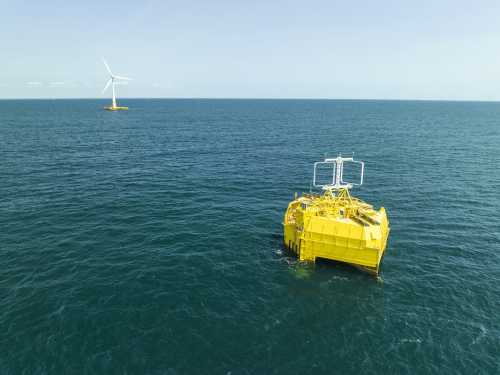
The Sealhyfe project, equipped with a 1 MW electrolyzer supplied by Plug, aimed to demonstrate that producing hydrogen offshore from renewable energy sources is already a reality. More specifically, the experiment aimed to:
Demonstrate Lhyfe’s ability to operate an industrial-scale production unit (1 MW) in an isolated environment;
Prove the reliability of the electrolysis technology in harsh environmental conditions that are representative of the operating conditions of its future large-scale offshore sites; and
Provide a database of operating data that can be used to optimise and make production processes more reliable, and to test the technologies employed with a view to scaling them up to sites with ten times and then 100 times greater capacity.
A range of measurement and data collection instruments were installed on board Sealhyfe to ensure precise management and control of all the production unit’s parameters from September 2022 to November 2023, first at the quayside and then at sea.
The review of test results and analysis of equipment after 14 months of trials found:
System responsiveness and versatility: As offshore hydrogen production is particularly relevant for providing services to the electricity grid, Lhyfe repeatedly tested the system’s versatility and responsiveness in a wide range of configurations. The experiment also confirmed the system’s ability to manage the variability of wind power in specific offshore conditions. The electrolysis system was operated as part of the planned research tests, including at maximum production capacity. The performance achieved was as high as on land, confirming the reliability of the installation.
Robustness: Throughout the trial, the production system equipment designed by Lhyfe was tested in extreme conditions for platform movement management, environmental stress, etc. In particular, Sealhyfe was confronted with five significant storms, including Ciaran, which swept along the Atlantic coast in October 2023, with waves over 10 metres high and winds of more than 150 km/h. A complete analysis of the production system once it was back on land confirmed that all equipment had returned unharmed with its production capacity intact.
Equipment and system optimization: Throughout the experiment, on-board and remotely-controlled measuring instruments were used to identify ways of optimising the efficiency and reliability of Lhyfe’s production units – including safety systems, electrical architecture, automation, fluid and stock management, etc. – for its other projects.
Remote control: The quayside benchmark testing phase helped to de-risk the project. The vast majority of impacts specific to offshore hydrogen production were identified and reduced. The site was then operated exclusively remotely from Lhyfe’s control centre, using supervision and control tools specifically developed by the company. The experiment made it possible to validate the software and algorithms for producing green and renewable hydrogen, and to reduce the number of operations required in the marine environment. In total, Lhyfe carried out fewer than ten maintenance operations and the system was operated for 70% of the operating time.
Regulatory developments: As part of this world first, Lhyfe also worked with the French authorities to define the operating rules for a green hydrogen production unit operating within an urban, industrial and port environment, and also capable of operating in the open sea.
Overall, the Sealhyfe project enabled Lhyfe to develop its expertise in handling the constraints associated with offshore industrial deployment, thanks in particular to its experience integrating an isolated, offshore plant on a floating barge at sea.
The results of this experiment are already being incorporated into the HOPE project, which represents the second stage in Lhyfe’s offshore ambitions. This project, which Lhyfe presented with a consortium of nine partners, was selected by the European Commission for a €20-million grant as part of the Clean Hydrogen Partnership, along with an additional €13-million grant from the Belgian government.
With HOPE, Lhyfe and its partners are changing scale and aiming to commercialise green hydrogen produced offshore. From 2026, this unprecedentedly large-scale project (10 MW) will be able to produce up to 4 tonnes per day of green hydrogen at sea, which will be exported ashore by pipeline, and then compressed and delivered to customers.
The Sealhyfe project will also ensure that the production processes at Lhyfe’s land-based sites are reliable and optimized from the outset, so that they can be ramped up quickly and progressively. Lhyfe’s ambition is to have a production capacity of up to 22 tonnes of green hydrogen per day by the end of 2024 and up to 80 tonnes per day by 2026.